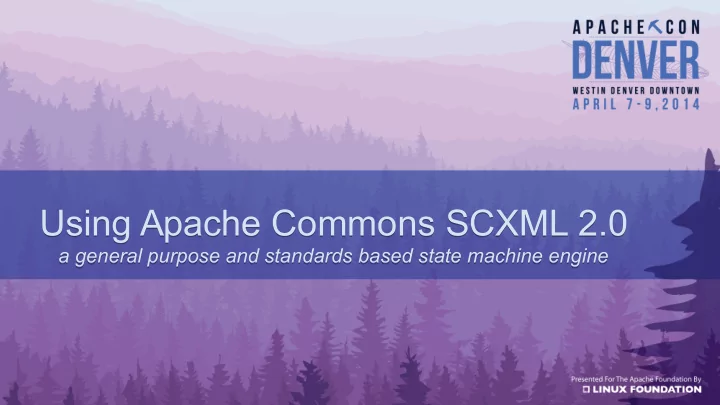

Using Apache Commons SCXML 2.0 Using Apache Commons SCXML 2.0 a general purpose and standards based state machine engine a general purpose and standards based state machine engine
Ate Douma R&D Platform Architect @ Hippo, Amsterdam Open Source CMS http://www.onehippo.org 10 years ASF Committer, 7 years ASF Member Committer @ Apache Commons Committer & PMC Member @ Apache Airavata, Incubator, Portals, Rave, Wicket & Wookie Mentor @ Apache Streams (incubating) ate@apache.org / a.douma@onehippo.com / @atedouma
Agenda • SCXML – quick introduction • Why use SCXML? • A brief history of Commons SCXML • Commons SCXML 2.0 • Features (trunk) • A simple demo • High level architecture • Using custom Actions • Use case: Hippo CMS document workflow • Roadmap
SCXML S tate C hart XML : State Machine Notation for Control Abstraction • an XML-based markup language which provides a generic state-machine based execution environment based on CCXML and Harel State charts. • Developed by the W3C: http://www.w3.org/TR/scxml/ • First Draft July 5, 2005. Latest Candidate Recommendation March 13, 2014 • Defines the XML and the logical algorithm for execution – an engine specification
A typical example: a stopwatch <?xml version="1.0" encoding="UTF-8"?> <scxml xmlns="http://www.w3.org/2005/07/scxml" version="1.0" initial="reset"> <state id="reset"> <transition event="watch.start" target="running"/> </state> <state id="running"> <transition event="watch.split" target="paused"/> <transition event="watch.stop" target="stopped"/> </state> <state id="paused"> <transition event="watch.unsplit" target="running"/> <transition event="watch.stop" target="stopped"/> </state> <state id="stopped"> <transition event="watch.reset" target="reset"/> </state> </scxml>
A bit more complex: a microwave <datamodel> <data id="cook_time" expr="5"/> <data id="door_closed" expr="true"/> <data id="timer" expr="0"/> </datamodel> <parallel id="oven"> <state id="engine"> <state id="door"> <initial> <initial> <transition target="off"/> <transition target="closed"/> </initial> </initial> <state id="off"> <state id="closed"> <transition event="turn.on" target="on"/> <transition event="door.open" target="open"/> </state> </state> <state id="on"> <state id="open"> <initial> <transition event="door.close" target="closed"/> <transition target="idle"/> </state> </initial> </state> <transition event="turn.off" target="off"/> <transition cond="timer >= cook_time" target="off"/> <state id="idle"> <transition cond="In('closed')" target="cooking"/> </state> <state id="cooking"> <transition cond="In('open')" target="idle"/> <transition event="time"> <assign location="timer" expr="timer + 1"/> </transition> </state> </state> </state> </parallel>
Why use SCXML? • Almost everyone uses some form of 'state machine', implicitly • Trivial state management typically becomes less trivial over time • Often the realization a proper state machine is needed, kicks in 'too late' • Use a generalized finite state machine like SCXML to: • better validate and test the state management and transition logic • encapsulate and generalize the processing logic, promote re-use • simplify and standardize the usage • support easier extend and customize • hook up 'listeners' into the state machine for extra/pre/post processing • The 'overhead' of using a proper state machine is almost always neglectable
Apache Commons SCXML A brief history • Started in 2005 • First release 0.5 in 2007, last release 0.9 in 2010 ... • First, and still only, open source Java implementation of the specification (there are several implementations though in Python, Ruby, C++, Javascript, Lua, etc.) • Version 0.9 (still) used quite a lot, including some commercial products • But ... the project got 'stalled' in 2010 with very little/no activity • The SCXML specification in the meantime however changed quite a bit... • Status until 4th quarter 2013: project seemed 'dead in the water', ready for the attic? No :) • Development has picked up again, rapidly working towards specification alignment • Next version will be Commons SCXML 2.0, with some radical (breaking) changes!
Commons SCXML 2.0 features (trunk) • SCXML processing algorithm now based on latest specification! • Full support for SCXML core model elements • SCXML datamodel and external communication support limited or not compliant (yet) • Hierarchical datamodel contexts, external 'root' context can be used to inject your data • Complete in memory Java model, 'bootstrap' you own SCXML model through code • Manual external event processing – run Commons SCXML embedded 'in process' • Apache Commons JEXL, Groovy and (limited) Javascript & XPath expressions • SCXMLListener notification support for receiving callbacks during event processing • Runtime SCXML instance state can itself be (de)serialized and persisted • Easy to use and add custom 'actions' • And most importantly: easy to embed, extend and customize!
Commons SCXML 2.0 A simple demo Showing a stopwatch example: • embedded in a Swing application, with a custom SCXMLListener connected to: • scxmlgui – A graphical editor for SCXML finite state machines. https://code.google.com/p/scxmlgui/ (Apache License 2.0)
Commons SCXML 2.0 High level architecture
Commons SCXML 2.0 Using custom actions • Note: all build-in SCXML executable content elements are Actions plenty of examples to go by: <if>, <foreach>, <script>, <log>, <send> , etc • Using custom Actions allows 'just about anything' to be wired into the SCXML processing • Just make sure they are Serializable, stateless and thread safe! Configuring custom Actions using a list of CustomAction wrappers for the SCXMLReader: List<CustomAction> customActions = new ArrayList<CustomAction>(); CustomAction ca = new CustomAction( "http://my.custom-actions.domain" // custom namespace , "action" // custom XML element local name , MyAction.class); // the actual custom Action class customActions.add(ca); SCXML scxml = SCXMLReader.read(url, new SCXMLReader.Configuration(null, null, customActions));
Commons SCXML 2.0 Using custom actions Writing the custom Action: public class MyAction extends Action { private static final long serialVersionUID = 1L; private String expr; public final void setExpr(final String expr) { this.expr = expr; } @Override public void execute(ActionExecutionContext exctx) throws ModelException, SCXMLExpressionException { Context ctx = exctx.getContext(getParentEnterableState()); ctx.setLocal(getNamespacesKey(), getNamespaces()); System.out.println("MyAction.expression result: " + exctx.getEvaluator().eval(ctx, expr).toString()); ctx.setLocal(getNamespacesKey(), null); } } Using the custom Action: <scxml xmlns="http://www.w3.org/2005/07/scxml" version=”1.0” xmlns:my="http://my.custom-actions.domain" initial=”custom”> <final id="custom"> <onentry> <my:action expr="1+1"/> </onentry> </final> </scxml>
Commons SCXML 2.0 Use case: Hippo CMS document workflow Hippo CMS is an open source Content Management System using Commons SCXML for its document workflow: • used to be 'hand coded', which was rather difficult to extend and customize • content and workflow state is stored in a JCR (Apache Jackrabbit based) repository • workflow process configuration (SCXML) is now also stored in the repository • Many workflow processes can be executing concurrently
Recommend
More recommend